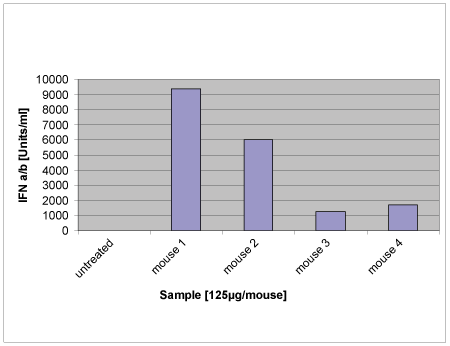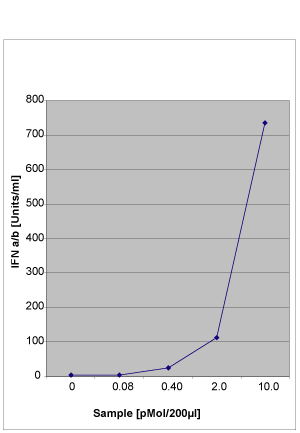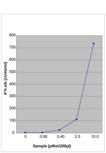- Specific activator of TLR3 and MDA5
- Used to generate stable mature dendritic cells
- Potential adjuvant in cancer vaccines
TLR3 is a key effector of the immune response against viruses by recognizing double-stranded RNA. Polyinosinic-polycytidylic acid (Poly(I:C)), a synthetic double-stranded homopolymer, binds TLR3 and activates the transcription factor interferon regulator factor 3 (IRF3) following the initiation of TIR domain-containing adaptor protein (TRIF)-dependent TLR signaling. Activation of IRF3 by poly(I:C) leads to the production of type I interferons. Poly(I:C) also activates the RNA helicases MDA-5 and RIG-1. Poly(I:C) can be used to generate stable mature dendritic cells in vitro and is considered a potent adjuvant in vaccine formulations, especially those targeting dendritic cells, thanks to the synergy between MDA5 and TLR3 activation.
Product Details
| Alternative Name: | poly(I:C) . K, poly(I:C) |
| |
| Formula: | (C10H10N4NaO7P)x • (C9H11N3NaO7P)x |
| |
| Source: | Synthetic. |
| |
| CAS: | 31852-29-6 |
| |
| Quantity: | Aliquoted by weight of dry material. Contains polymer, residual salt and water. Sufficient for at least 200 cellular activation assays at 10-25µg/ml. |
| |
| Formulation: | Lyophilized. Sterile. |
| |
| Purity Detail: | Activity and endotoxin tested - TLRGRADE®. |
| |
| Endotoxin Content: | <0.002EU/µg (LAL test; BioWhittaker) |
| |
| Reconstitution: | For a 1mg/ml stock solution, dissolve the total vial content in 2ml (ALX-746-021-M002) or 5ml (ALX-746-021-M005) endotoxin-free buffer or water. To obtain optimal dissolving we recommend the following procedure: - Add 50% of the solvent and let dissolve for 10 min. - Add remaining 50% of the solvent and mix thoroughly. - Moderate warming may aid dissolving. |
| |
| Shipping: | Ambient Temperature |
| |
| Long Term Storage: | +4°C |
| |
| Use/Stability: | Aqueous stock solution is stable for 1 day when stored at +4°C. |
| |
| Handling: | Protect from light. For maximum product recovery after thawing, centrifuge the vial before opening the cap. After reconstitution, prepare aliquots and store at -20°C. |
| |
| Regulatory Status: | RUO - Research Use Only |
| |

Figure 2: Poly(I:C) . K (TLRGRADE®) (synthetic) (Prod. No.
ALX-746-021) induces cytokine release in mouse
in vivo.
Method: Poly(I:C) was injected i.v. and plasma levels of IFN α/β were determined 2 hours later by cytokine ELISA.

Figure 1: Poly(I:C) . K (TLRGRADE®) (synthetic) (Prod. No.
ALX-746-021) induces cytokine release in murine BM-derived macrophages.
Method: Poly(I:C) was added to bone marrow-derived murine macrophages in a 96-well plate at the indicated concentrations, cell supernatants were harvested after 24 hours and IFN α/β levels analyzed by cytokine ELISA.
Please mouse over
Product Literature References
CCL5-producing migratory dendritic cells guide CCR5+ monocytes into the draining lymph nodes: K. Rawat, et al.; J. Exp. Med.
220, e20222129 (2023),
Abstract;
Nicotinamide mononucleotide (NMN) alleviates the poly(I:C)-induced inflammatory response in human primary cell cultures: H. Sano, et al.; Sci. Rep.
13, 11765 (2023),
Abstract;
Synthetic circular RNA switches and circuits that control protein expression in mammalian cells: S. Kameda, et al.; Nucleic Acids Res.
51, e24 (2023),
Abstract;
Function conservation and disparities of zebrafish and human LGP2 genes in fish and mammalian cells responsive to poly (I: C): X. Gong, et al.; Front. Immunol.
13, 985792 (2022),
Abstract;
Full Text
Human cDC1s express in-doleamine 2, 3-dioxygenase 1 (IDO) with functional effects on T cell priming: S.P. Sittig, et al.; Eur. J. Immunol.
51, 1494 (2021),
Abstract;
IRF-8/miR-451a regulates M-MDSC differentiation via the AMPK/mTOR signal pathway during lupus development: G. Shi, et al.; Cell Death Discov.
7, 41420 (2021),
Abstract;
N4BP1 negatively regulates NF-κB by binding and inhibiting NEMO oligomerization: H. Shi, et al.; Nat. Commun.
12, 1379 (2021),
Abstract;
Role of extracellular microRNA-146a-5p in host innate immunity and bacterial sepsis: S. Wang, et al.; iScience
24, 103441 (2021),
Abstract;
Full Text
Time-Lapse Imaging of Necroptosis and DAMP Release at Single-Cell Resolution: S. Murai , et al.; Methods Mol. Biol.
2274, 353 (2021),
Abstract;
TLR2- and TLR3-activated microglia induce different levels of neuronal network dysfunction in a context-dependent manner: S. Schilling, et al.; Brain Behav. Immun.
17, 889 (2021),
Abstract;
Identification of the hallmarks of necroptosis and ferroptosis by transmission electron microscopy: S. Miyake, et al.; Biochem. Biophys. Res. Commun.
527, 839 (2020),
Abstract;
Metabolic sialic acid blockade lowers the activation threshold of moDCs for TLR stimulation: C. Büll, et al.; Immunol. Cell Biol.
94, 408 (2017),
Abstract;
Human blood myeloid and plasmacytoid dendritic cells cross activate each other and synergize in inducing NK cell cytotoxicity: J.J.P. van Beek, et al.; Oncoimmunology
5, e1227902 (2016),
Application(s): Human Dendritic Cells stimulation,
Abstract;
Full Text
Enterovirus-Infected β-Cells Induce Distinct Response Patterns in BDCA1+ and BDCA3+ Human Dendritic Cells: B. M. Schulte, et al.; PLoS One
10, e0121670 (2015),
Application(s): Cell Culture,
Abstract;
Full Text
CD14 and TRIF govern distinct responsiveness and responses in mouse microglial TLR4 challenges by structural variants of LPS: T. Regen, et al.; Brain Behav. Immun.
25, 957 (2011),
Abstract;
Activation of murine macrophages via TLR2 and TLR4 is negatively regulated by a Lyn/PI3K module and promoted by SHIP1: S. Keck, et al.; J. Immunol.
184, 5809 (2010),
Abstract;
Full Text
Human Langerhans cells selectively activated via Toll-like receptor 2 agonists acquire migratory and CD4+T cell stimulatory capacity: M. Peiser, et al.; J. Leukoc. Biol.
83, 1118 (2008),
Abstract;
Differential roles of MDA5 and RIG-I helicases in the recognition of RNA viruses: H. Kato, et al.; Nature
441, 101 (2006),
Abstract;
The dsRNA binding site of human Toll-like receptor 3: J.K. Bell, et al.; PNAS
103, 8792 (2006),
Abstract;
Subcellular localization of Toll-like receptor 3 in human dendritic cells: M. Matsumoto, et al.; J. Immunol.
171, 3154 (2003),
Abstract;
General Literature References
Noncanonical inflammasome activation by intracellular LPS independent of TLR4.: N. Kayagaki, et al.; Science
341, 1246 (2013),
Abstract;
Related Products














